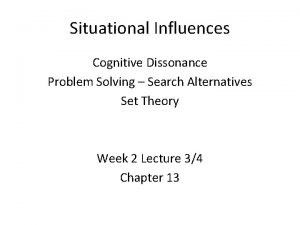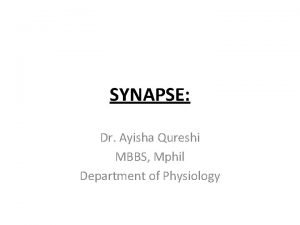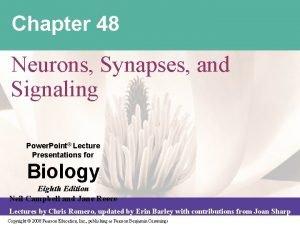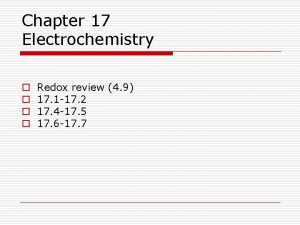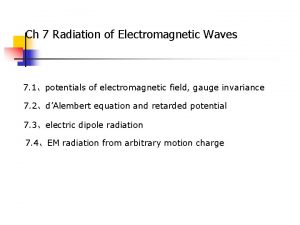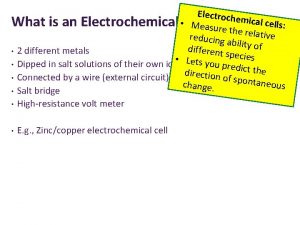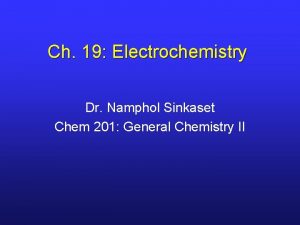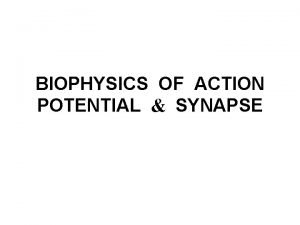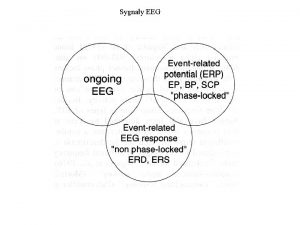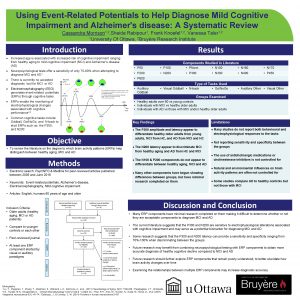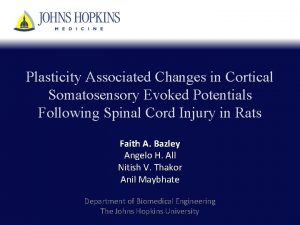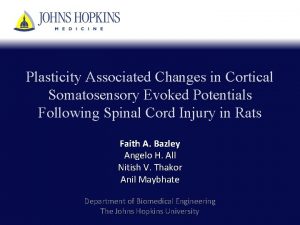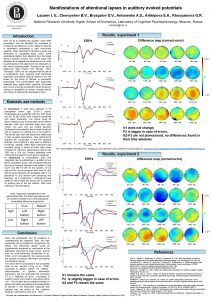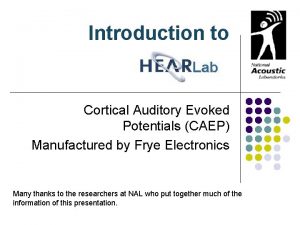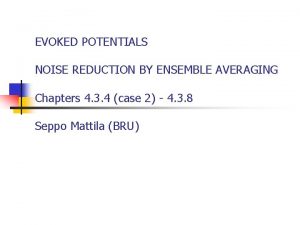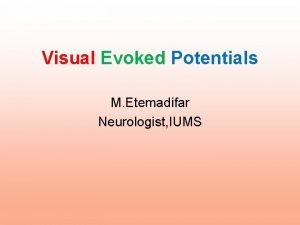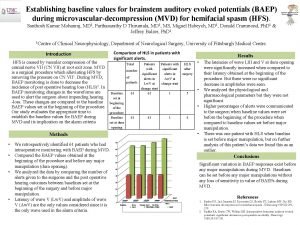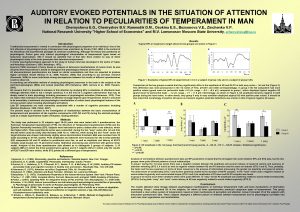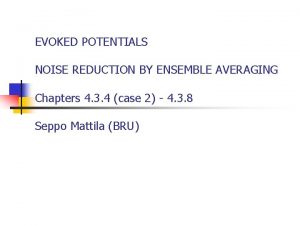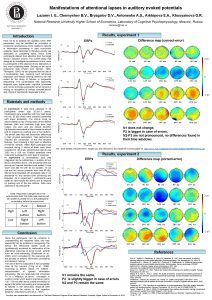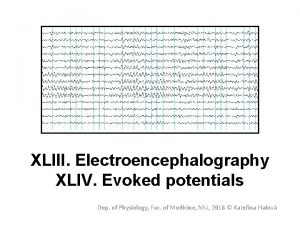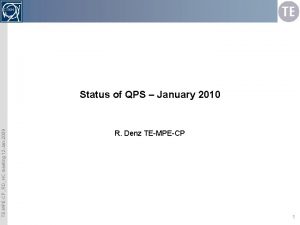27 Jan2009 Evoked Event and Related EventRelated Potentials























- Slides: 23

27 -Jan-2009 Evoked Event and Related Event-Related Potentials (ERP): (ERP) Basics (Part 1 - Neurophysiological and 1) Anatomical Basis of Scalp-Recorded Activity Craig E. Tenke & Jürgen Kayser Division of Cognitive Neuroscience, New York State Psychiatric Institute, NY Department of Psychiatry, Columbia University College of Physicians & Surgeons, NY Acronym ERP (wikipedia examples) • towns (Geography: in southern France, Germany, Netherlands) • enterprise resource planning (Information Technology) • Ethernet Ring Protection (Information Technology) • erotic role-playing (Sexuality) • Economic Report of the President (Economics) • effective refractory period (Medicine: cardiac cycle) • Estonian Reform Party (Politics) • Electronic Road Pricing (Politics: toll-collection scheme in Singapore) • European Recovery Program (History: Marshall Plan) • European Radio Project (Communication: European Radio Network) • exposure and response prevention (Psychology: cognitive-behavioral treatment method) • event-related potential (Physics: an electrophysiological response to an internal or external stimulus)

Outline Part 1: Neurophysiological and Anatomical Basis of Scalp-Recorded Activity o Introduction: EEG measures synchronized neuronal activity (signal source) o The basic scientific method • Stimulation - Recording • Signal tracing/processing o Signal averaging: Evoked potentials (EPs) and event-related potentials (ERPs) • Theory of signal averaging • Animated examples • ERP applications • ERP topographies: Indicators of neuroanatomy o EEG biophysics • Volume Conduction and Ohm’s Law: Point generators • Vector formulation: A general model • Closed vs. open fields o The cortical dipole: Direct evidence o A matter of scale: Micro- vs. macro- and intracranial vs. scalp electrodes Part 2: Data acquisition and analysis: Conventions for scalp-recorded ERPs o (details to be decided)

Evoked and Event-Related Potentials (ERP) Part 1 Neurophysiological and Anatomical Basis of Scalp-Recorded Activity

What does EEG measure? Changes in the extracellular potential corresponding to membrane polarization

Polarity reflects location of cellular activity Equivalent Current Dipole from apical EPSP Equivalent Current Dipole from deep EPSP

Importance of synchronized activity Desynchronized PSP’s voltages cancel “Closed Field” (No EEG at Scalp)

Importance of synchronized activity Synchronized PSPs voltages add “Open Field” (EEG at scalp)

Scalp-recorded EEG is measurable • when local neuronal activity is synchronized (time) • when activity produces an open field (space) • when activity at the recording site differs from the reference

Stimulation-Recording methods use timelocking to synchronize activity

Stimulation-Recording Methods: Tracing signals through a “Black Box” To find System Properties Compare Input Signal Transit time: With Output Signal e. g. synaptic delay across a sensory nucleus Response Function: Filtering and gain of output waveform Nonlinear properties (e. g. flicker fusion) Signal Tracing: Waveform latency, shape and topography e. g. cortical mapping

Compound Action Potential: A Stimulation-Recording Archetype up is negative; right is reference Mann 1997 Erlanger & Gasser Threshold Intensity Differential Threshold 80 mm from stimulus Differential Velocity

Schandry 1989 Evoked Potential (EP) • time-locked electrical response of a neural system to an electrical or sensory signal Averaged Evoked Potential • average of time-locked EPs • EPs may vary considerably across trials (averaging is generally necessary)

Examples of Averaged ERP Auditory Oddball ERP (average) Visual Hemifield ERP (average) Nontargets Targets Kayser (2001) from Psychophysiology Lab website (http: //psychophysiology. cpmc. columbia. edu)

Schandry 1989 Evoked Potential (EP) • time-locked electrical response of a neural system to an electrical or sensory signal Averaged Evoked Potential • average of time-locked EPs • EPs may vary considerably across trials (averaging is generally necessary) Event-related Potential (ERP) • Generalized EP timelocked to a stimulus, response, or informational event (e. g. , missing stimulus in series of stimuli)

Applications of ERPs 1) Pathology: slowing or distortion of EP 2) Information processing (incl. perception, cognition) 3) Functional mapping: parallel other neuroanatomical methods Ramon y Cajal Mountcastle & Henneman(1952)

ERP topographies have anatomical implications! Topographies reflect macroscopic and microscopic anatomy

EEG Biophysics: Volume Conduction and Ohm’s Law V= I /R Voltage is directly proportional to current, and inversely related to resistance For a point generator in a conductive medium, resistance is related to distance: Voltage Potential is directly proportional to I and inversely related to distance (d) current Tenke et al (1993))

EEG Biophysics: Volume Conduction implies Spatial Integration 4 electrodes point source As the generator becomes wider, the falloff becomes linear and shallow

EEG Biophysics: Complete Volume Conduction Model Vector form of Ohm’s Law (proportionality of current flow and electric field vectors) Problem: Neither current nor voltage are in this equation! This fundamental relationship Current Source Density (Im) also underlies inverse models! is a scalar This is Poisson’s source equation relating current generators to voltage potentials Tenke et al 1993

Field closure is quantitative, not qualitative Simulated dipole laminae 50% inverted dipoles yield closed field 25% inverted yield open field

Depth in mm (orthogonal penetration) The Cortical Dipole Intracortical profiles reveal complexity of processing Within cortex field potential profiles reach maximum and invert in deeper layers “Cortical Dipole” hypothesized from cortical projection cell asymmetry and supported superficial-to-deep polarity inversions Tenke et al (unpublished))

A matter of scale: Intracranial recordings Intracellular recordings Extracellular recordings Multicontact extracellular recordings ion channels, Local Field Potentials: synaptic currents, postsynaptic potentials and unit discharges (m. V range) Selectivity for Local Activity! • High-impedance electrodes • proximal to generators • far from external noise sources Local Field Potentials: Summated PSPs, units and multiunits

A matter of scale: Surface and scalp recordings Scalp recordings Lower impedance electrodes Additional smearing Larger electrodes integrate over more tissue (bone & skin) More distant from generators Smaller amplitude compared Further smearing by volume conduction to EOG, EKG etc. (u. V range) (smaller, composite signals) Proximity to EMG sources
 Evoked set of brands
Evoked set of brands Evoked set
Evoked set Evoked set of brands
Evoked set of brands Evoked set
Evoked set Intergroup gifting
Intergroup gifting Evoked set of brands
Evoked set of brands Consumer decision rule
Consumer decision rule Evoked set
Evoked set Gaze evoked nystagmus test
Gaze evoked nystagmus test Analyzing voice in literature
Analyzing voice in literature Physical fitness is of two types
Physical fitness is of two types Skills related
Skills related Event-related potential advantages and disadvantages
Event-related potential advantages and disadvantages Subliminal fringe
Subliminal fringe Sources of biopotential
Sources of biopotential Graded potential vs action potential
Graded potential vs action potential Define graded potential
Define graded potential Postsynaptic potentials
Postsynaptic potentials Table of standard reduction potentials
Table of standard reduction potentials Lienard-wiechert potentials
Lienard-wiechert potentials Cathode anode standard reduction potential
Cathode anode standard reduction potential Task 8 electrode potentials answers
Task 8 electrode potentials answers Use the tabulated half-cell potentials to calculate
Use the tabulated half-cell potentials to calculate What are electrical synapses
What are electrical synapses
